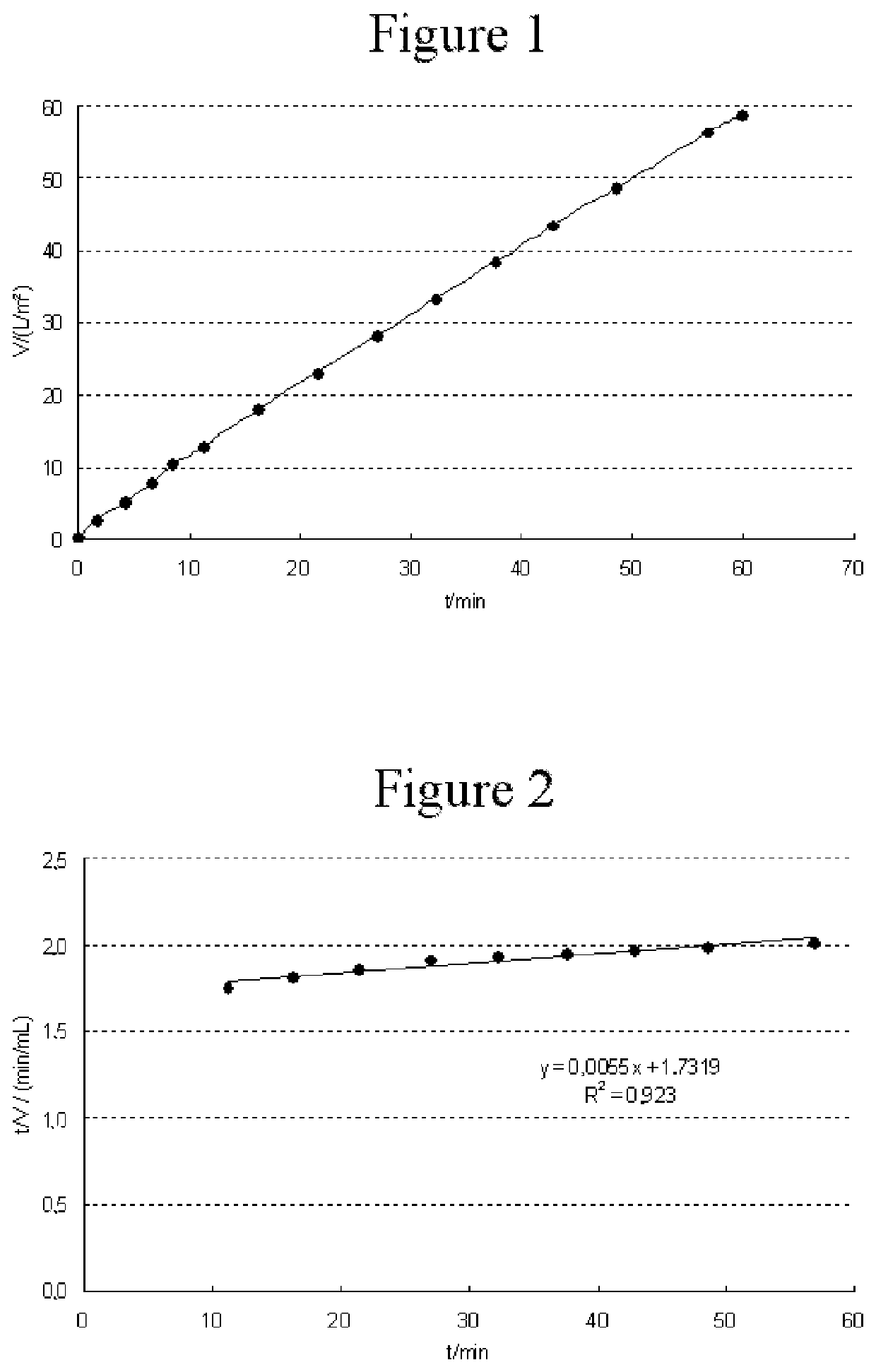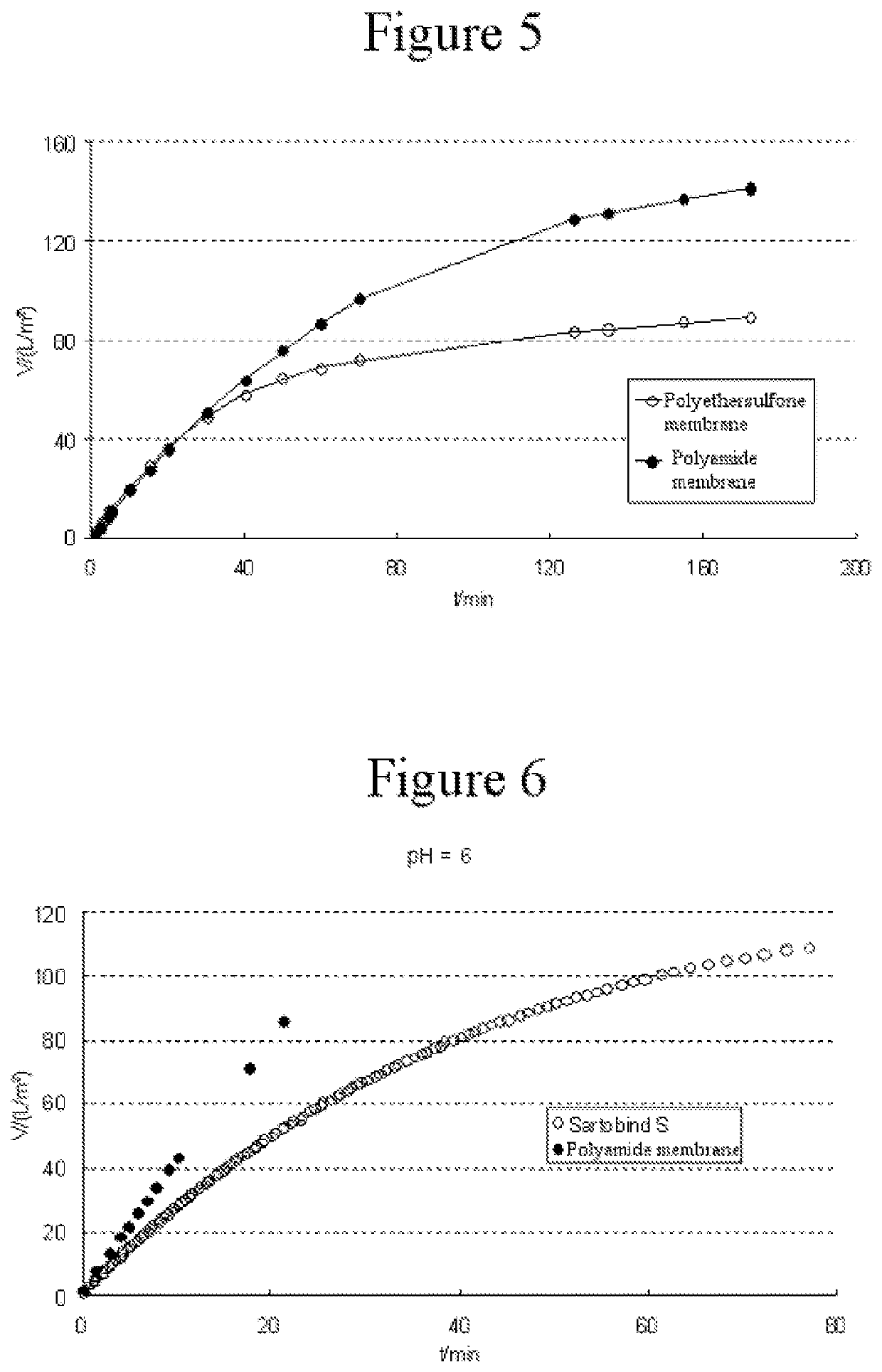Method for removing biopolymer aggregates and viruses from a fluid
a technology of biopolymer aggregates and fluids, applied in membrane technology, disinfection, membranes, etc., can solve the problems of large optimization effort, complex production of suitable so-called parvovirus filters compared to microfiltration membranes for other applications, and inconvenient removal of said aggregates by size-exclusion filtration, etc., to achieve the effect of increasing the filtration capacity of virus filters, reducing the filtration capacity of viruses, and reducing the filtration capacity
- Summary
- Abstract
- Description
- Claims
- Application Information
AI Technical Summary
Benefits of technology
Problems solved by technology
Method used
Image
Examples
example 1
n of a Protein Solution of a Monoclonal Antibody from the Cell Line CHO dg44 ST1-C6
[0044]The monoclonal antibody in the protein solution originates from the cell line CHO dg44 ST1-C6 and was made available by means of the following method:
[0045]Firstly, a cell culture in which the target protein was produced was set up. Culturing took place under usual conditions known to a person skilled in the art, using a Biostat® CultiBag RM single-use bioreactor (Sartorius Stedim Biotech GmbH) with a culture volume of 25 L and an inoculation cell density of 5×105 cells / mL and the growth medium Pro CHO5 (Lonza BE12-766P).
[0046]After attainment of the maximum cell density after 9 days, the cells were harvested and purification carried out. In a typical method, the cell suspension was firstly filtered across depth filter layers and particle filters having a pore size of 0.2 μm. The antibody was isolated from the cell-free solution in chromatographic methods, such as protein A affinity chromatograp...
example 2
n of a Solution of a Human IgG Protein
[0052]For the filtration, a solution of a human IgG protein (5% strength solution, SeraCare, catalog No. HS-475-1L) diluted with phosphate buffer, pH 6.6 (Sigma Aldrich, catalog No. P8165), and EDTA (Sigma Aldrich, catalog No. E6758) to a concentration of 10 g / L protein and 10 mM EDTA was used. The solution was contacted, in step (a), with a porous polyamide surface composed of nylon-6 in the form of a microporous membrane (pore size 0.1 μm, external area 7 cm2) by filtration normal to the external surface. Subsequently, in step (b), the filtrate from step (a) was filtered normally across a double-layer Virosart® CPV Minisart virus filter (area 5 cm2, Sartorius Stedim Biotech GmbH) at 2 bar.
example 3
tion of pH Dependence
[0056]A protein solution was prepared as described in example 1, and the concentration was adjusted to 10 g / L. The pH was adjusted via changes in the buffer composition with the aid of citric acid (Sigma Aldrich, catalog No. C2404) and tris base (2-amino-2-(hydroxymethyl)propane-1,3-diol, Sigma Aldrich, catalog No. T1503) to pH=6.0 and 9.0, respectively. The two protein solutions were adjusted to a uniform conductivity of 15 mS / cm by addition of sodium chloride (Sigma Aldrich, catalog No. S5886). Both solutions were filtered across a Sartopore® 2 polyethersulfone membrane (pore size 0.1 μm) in order to exclude the effects of different pore sizes in further prefiltration steps. In step (a), the protein solutions were filtered across either a charged Sartobind® S membrane (external area 6 cm2, Sartorius Stedim Biotech GmbH) or a microporous polyamide membrane (pore size 0.1 μm, external area 6 cm2). In step (b), the solutions were filtered across one layer of a Vi...
PUM
| Property | Measurement | Unit |
|---|---|---|
| conductivity | aaaaa | aaaaa |
| conductivity | aaaaa | aaaaa |
| pore size | aaaaa | aaaaa |
Abstract
Description
Claims
Application Information
 Login to View More
Login to View More - R&D
- Intellectual Property
- Life Sciences
- Materials
- Tech Scout
- Unparalleled Data Quality
- Higher Quality Content
- 60% Fewer Hallucinations
Browse by: Latest US Patents, China's latest patents, Technical Efficacy Thesaurus, Application Domain, Technology Topic, Popular Technical Reports.
© 2025 PatSnap. All rights reserved.Legal|Privacy policy|Modern Slavery Act Transparency Statement|Sitemap|About US| Contact US: help@patsnap.com



